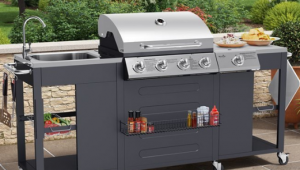Jump to:
Maintaining a thriving garden is a labour of love, and your closest allies in this journey? Gardening tools.
However, neglecting their care could be undermining your green-thumb efforts. So get rid of those dirt, rust, and diseases, and preserve the longevity of your trusty implements. Use this guide to ensure your companions remain reliable throughout your cultivating seasons.
Why Cleaning Garden Tools is Essential

Cleaning before and after use is not just a chore; it’s a vital aspect of responsible gardening. Soil, plant debris, and pathogens have a knack for accumulating on tools over time. Neglecting their maintenance can lead to reduced effectiveness. In some cases, it can even jeopardise your garden’s health. For one, soil and debris can introduce pests and diseases to your plants. Pathogens from one plant can also easily hitch a ride on unclean tools to infect others.
By regularly cleaning your garden tools, you’re ensuring their longevity. Even better, it safeguards the vitality and vibrancy of your green space.
Gather the Necessary Supplies
To ensure your garden tools stay in top shape, gather the following items for cleaning:
- a sturdy bucket to hold water
- water itself for soaking and rinsing
- a scrub brush for removing stubborn dirt
- mild detergent to cut through grime
- a lubricating oil to prevent rust
- a cloth for drying and wiping down the tools
With these supplies on hand, you’ll be well-equipped to maintain your planting stuff.
Cleaning Hand Tools

Cleaning hand tools, including a leaf scoop, is a straightforward yet vital process. Here’s a step-by-step guide:
- Remove soil and debris: Start by scraping any soil, mud, or plant debris from the tool’s surface. A stiff brush or a putty knife works well for this.
- Soak the tools in soapy water: Fill your bucket with warm, soapy water. Submerge the tools, ensuring that all parts are covered. Let them soak for about 15-20 minutes. This will loosen the remaining dirt and make it easier to clean.
- Scrub and rinse: After soaking, use a scrub brush or an old toothbrush to scrub away any remaining dirt or rust. Pay special attention to crevices and corners. Rinse the tools thoroughly with clean water to remove all soap residues.
- Dry and oil the tools: Ensure the tools are completely dry before storing them. Wipe them down with a cloth to remove any remaining moisture. Then, apply a thin coat of lubricating oil to prevent rust and maintain cutting edges.
- Tips for maintaining wooden handles: Wooden handles need extra care. Sand down rough spots and splinters. Finish with a coat of linseed oil to keep them smooth and prevent cracking. Regularly check for signs of wear or damage and address them promptly.
Cleaning Power Tools

Safety should always be a top priority when cleaning power tools. Before starting, disconnect the power source, whether a battery or a power cord. This prevents accidental starts that can lead to serious injury.
Additionally, wear appropriate personal protective equipment. Gloves and safety glasses can shield you from sharp edges and flying debris.
Cleaning power tools like pruners or trimmers
Follow these steps:
- Disconnect the power source: Ensure the tool is completely disconnected from its power.
- Remove debris: Carefully remove any debris, sap, or plant matter from the blades. Use a brush or a putty knife.
- Clean blades or cutting surfaces: Wipe the blades with a cloth soaked in a detergent solution. Scrub gently to remove stubborn residue.
- Lubricate moving parts: Apply a suitable lubricant to the moving parts. These include the pivot points and springs, maintaining smooth operation.
Specific cleaning instructions may vary depending on the type of the power tool. Always refer to the manufacturer’s guidelines for your specific tool. This ensures proper cleaning and maintenance overall.
Caring for Garden Gloves

(Image Credit: Wikimedia Commons)
Dirty gloves can transfer pathogens between plants. Meanwhile, neglected gloves may wear out quickly, compromising hand protection. Here’s how to keep yours clean and in good shape:
- Rinse off dirt and debris after each use.
- Hand wash or machine wash according to care instructions.
- Air dry gloves to prevent damage from high heat.
- Store them in a cool, dry place to avoid mould and mildew growth.
Regular Maintenance Schedule
Setting a regular cleaning schedule is a smart gardening practice with several benefits. It helps maintain tool performance and extends its lifespan.
For optimal results, consider cleaning tools after each use. Doing so helps prevent the buildup of soil and pathogens. And at the end of each gardening season, prepare them for storage. This routine maintenance ensures your tools remain reliable and your garden thrives.
Looking for top-quality but cheap gardening tools? BillyOh has got you covered! We also have tools accessories and spares, so make sure to check them out.
Here’s your next recommended read: The Essential Tools You Need for Gardening













What do you think ?